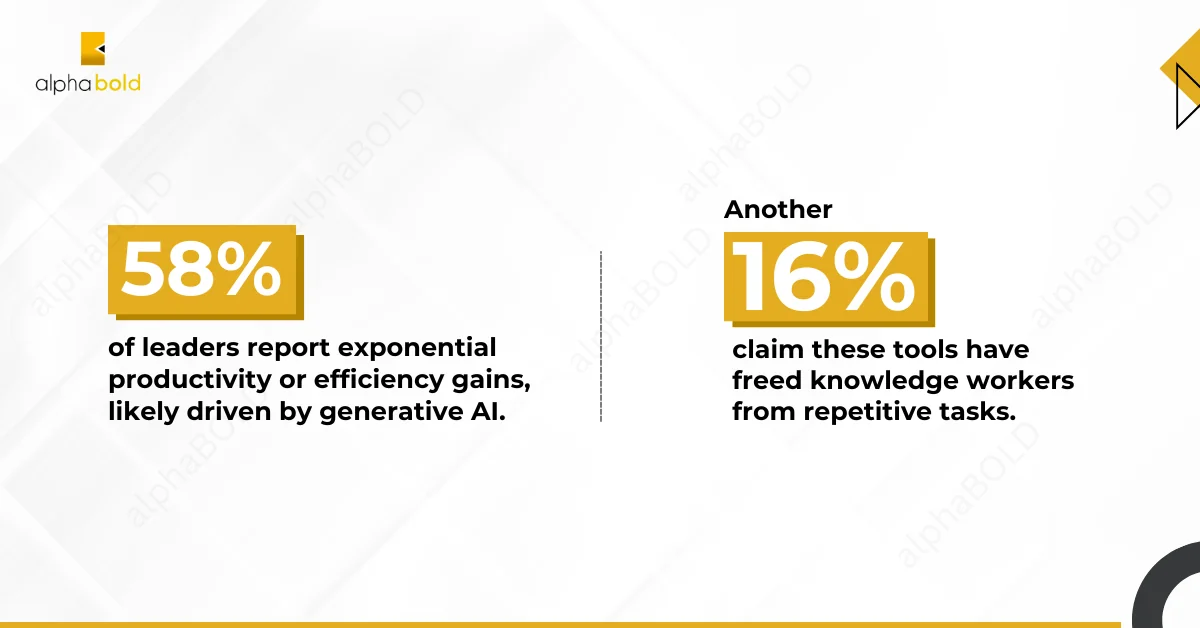Top Generative AI Trends Shaping 2025’s Agenda: Guide for Business Leaders

Ifra Amin
Table of Contents
Introduction
As we step into 2025, businesses are navigating a critical juncture in aligning their Artificial Intelligence strategies with rapidly evolving technological advancements. The solutions from latest Generative AI trends are emerging as powerful tools, driving innovation and reshaping operational frameworks across industries.
The rise of generative AI, the proliferation of AI-driven agents, and the smooth integration of human and digital skills across the workforce underscores a paradigm shift in the modern workplace. AI is no longer just confined to experimentation. It is becoming integral to strategic planning, revolutionizing critical areas such as customer engagement, supply chain management, and human resources. According to Deloitte’s Global 2025 Predictions Report, by the end of 2025, a quarter of enterprises employing generative AI will have deployed AI agents, which is expected to double by 2027.
This blog will explore the top five generative AI trends shaping 2025’s business agenda and serve as a roadmap for forward-thinking leaders. Organizations can position themselves at the forefront of innovation and growth by understanding and embracing these trends.
Top 5 Generative AI Trends Every Business Leader Must Know for 2025
Trend 1: Measuring the Impact of Generative AI Experiments
The time has come for organizations to move beyond hype and quantify the results of their generative AI initiatives. While enthusiasm for AI agents is growing, one persistent challenge remains: demonstrating clear economic value from these technologies. In last year’s AI trends, the need to validate Generative AI’s value was highlighted, and the sentiment persists as we enter 2025.
Encouragingly, data from the 2025 AI & Data Leadership Executive Benchmark Survey shows promise:
- 58% of leaders report exponential productivity or efficiency gains, likely driven by generative AI.
- Another 16% claim these tools have freed knowledge workers from repetitive tasks.

These positive indicators suggest that Generative AI has the potential to deliver significant value—but optimism alone isn’t enough.
The reality is that many companies are not rigorously measuring these gains. Few have implemented controlled experiments or carefully tracked what employees do with the time freed by automation. Academic studies on Generative AI’s impact show modest productivity improvements but fall short of the exponential gains many anticipate.
For example, Goldman Sachs measured a 20% productivity boost among developers using Generative AI for programming. However, other studies suggest the impact varies, often depending on factors like workers’ experience levels or task complexity.
To truly understand and capitalize on Generative AI’s potential, companies must design vigorous experiments. For instance, one group of marketers might use Generative AI tools for content creation without human review, another with review, and a control group with no AI involvement. Comparing outcomes from these groups can offer valuable insights. Yet, measuring speed and quality is crucial—if AI generates content quickly but the results are inaccurate or uninspiring, the value proposition diminishes.
Moreover, the assumption that exponential productivity gains will translate into widespread efficiency may face a stark reality. Without large-scale layoffs reflected in employment data, the question remains: where are these gains being realized? Even Nobel laureate economist Daron Acemoglu has expressed skepticism, predicting only modest productivity growth from AI, perhaps a 0.5% increase over the next decade.
Ultimately, for organizational leaders to fully reap the benefits of Generative AI, they must invest in carefully measuring outcomes, conducting experiments, and maintaining a balanced view of its potential. Only then can they make informed decisions that drive genuine business value.
Trend 2: Generative AI Alone Can Not Build a Data-Driven Culture
Generative AI has gained global attention for its revolutionary capabilities, but it is not a one-size-fits-all solution for achieving a truly data-driven culture. Last year, a survey showed a significant increase in organizations reporting data- and AI-driven operations. The percentage of data-driven organizations rose from 24% to 48%, and those claiming a data-driven culture jumped from 21% to 43%. Many attributed this sharp rise to the growing adoption of generative AI.
However, the landscape in 2025 paints a more complicated picture. The latest survey reveals that only 37% of organizations now consider themselves data- and AI-driven, while 33% report having a data-driven culture. The regression in these numbers underscores a key insight: generative AI alone cannot drive the profound cultural transformation necessary for organizations to become truly data driven.
The survey also highlights a major challenge—92% of respondents identified cultural and change management issues as the primary obstacles to becoming data- and AI-driven. This emphasizes that technology, on its own, is insufficient. Many legacy organizations, which make up a significant portion of the respondents, struggle with deeply ingrained operational norms. While the pandemic accelerated digital adoption in these companies, their journey toward cultural transformation remains slow and complex.
The takeaway for business leaders is clear: generative AI can accelerate data use and improve decision-making, but achieving a fully data-driven culture requires a rigorous effort to overcome entrenched mindsets and build organizational alignment. Leadership must invest in change management, foster cross-functional collaboration, and embed data-driven thinking into everyday processes. Additionally, partnering with experienced AI consultants can provide valuable guidance in navigating these challenges, ensuring that generative AI is implemented effectively and aligned with organizational goals. Without these critical elements, the full potential of generative AI will remain out of reach.
Trend 3: The Resurgence of Unstructured Data
Generative AI has sparked a renewed focus on unstructured data, positioning it as an organization’s critical asset. According to the 2025 AI & Data Leadership Executive Benchmark Survey, 94% of data and AI leaders acknowledge that the surge in AI interest has driven a greater emphasis on data.
While traditional analytical AI has long relied on structured data, generative AI thrives on unstructured formats like text, images, and video. This shift is forcing companies to revisit their data strategies, especially for managing unstructured data, which many have largely ignored since the early days of knowledge management.
Consider this: a leader at a large insurance company recently revealed that 97% of the company’s data is unstructured. For such organizations, generative AI presents an opportunity to extract value from these untapped assets. Techniques like retrieval-augmented generation (RAG) allow companies to leverage unstructured data by enabling AI to search, retrieve, and synthesize information from internal documents. Yet, many firms remain unprepared, having spent years focused exclusively on structured data—rows and columns from transactional systems—while neglecting the vast potential of their unstructured repositories.
Companies must undertake significant groundwork to utilize unstructured data effectively. This includes identifying representative examples of each document type, tagging or graphing the content, and integrating it into AI-friendly systems. Technologies like embeddings, vector databases, and similarity search algorithms make this possible, but the process is far from automated. Curating and organizing data requires a concerted human effort.
While the idea of simply uploading a trove of internal documents into a Generative AI system sounds promising, it’s unlikely to be a reality in 2025. Even when AI tools reach that level of sophistication, human curation will remain vital. After all, AI alone cannot discern which of 20 similar sales proposals is the most relevant or effective.
This trend underscores the importance of investing in robust data management practices for business leaders. Generative AI can unlock tremendous value from unstructured data, but it requires a blend of advanced technology and human expertise to deliver meaningful results.
Your AI Journey Starts Here
AlphaBOLD is committed to making your transition to AI seamless and impactful. With our expertise, you’ll gain the tools, insights, and strategies needed to thrive in an AI-driven world. Book a consultation today, and let’s explore how generative AI can elevate your business.
Request a ConsultationTrend 4: Multi-Modal AI and Conversational AI Redefining Interactions
Multi-modal generative AI is revolutionizing the AI landscape and is expected to account for at least 40% of generative AI solutions by 2027. This innovation integrates data from multiple formats—text, images, audio, and video—enabling AI systems to analyze and interpret information as holistically as the human brain. By leveraging deep learning algorithms, multi-modal AI enhances decision-making and fosters deeper, more intuitive engagement across industries.
One powerful application of this trend can be seen in retail, where combining in-store camera footage, customer speech, and online behavior creates a comprehensive view of customer experiences. This enables real-time, personalized recommendations tailored to specific moments. Similarly, multi-modal AI is transforming corporate training by delivering immersive, simulated learning environments for employees, boosting knowledge retention and skill development.
In parallel, conversational AI is evolving rapidly, set to transform customer service by making virtual assistants smarter, more context-aware, and capable of handling increasingly complex interactions.
Improved AI capabilities in understanding context, sentiment, and intent are enabling more precise responses and allowing businesses to automate complex operations. Beyond enhancing customer service, conversational AI is expanding its reach into sectors like healthcare and finance, where timely and accurate communication is critical. These developments are equipping organizations to offer seamless, human-like interactions that drive efficiency and customer satisfaction.
For business leaders, multi-modal and conversational AI represents a unique opportunity to reimagine how they engage with customers, employees, and stakeholders. By adopting these tools, companies can improve operational efficiency and create richer, more meaningful interactions.
Trend 5: Hyper-Personalized Marketing Takes Center Stage
Hyper-personalized marketing, powered by generative AI, is revolutionizing how businesses connect with their audiences. By analyzing vast amounts of data, generative AI identifies individual consumer needs and preferences with unparalleled precision, allowing companies to tailor their services and offerings like never before.
Unlike traditional marketing, which relies on broad demographic segmentation, generative AI enables dynamic and real-time personalization. Businesses can now craft targeted ads and offers that resonate deeply with their ideal customer profiles (ICPs) at every journey stage. This approach enhances engagement, increases conversion rates, and builds stronger customer relationships. Research shows that adopting hyper-personalized strategies can reduce customer acquisition costs by nearly 50% and boost revenues by 5 to 15%.
For instance, in the education sector, AI-powered learning platforms adapt content based on a student’s progress, interests, and learning pace. This level of personalization enhances learning outcomes while keeping students engaged and motivated. Similarly, in retail and e-commerce, hyper-personalized product recommendations drive repeat purchases and foster brand loyalty.
Business leaders who leverage this generative AI trend for bespoke marketing experiences will gain a significant edge in 2025. By delivering the right message to the right audience at the right time, organizations can enhance customer satisfaction and foster long-term loyalty and sustainable growth.
How Can AlphaBOLD Help?
At AlphaBOLD, we understand that AI integration is both an opportunity and a challenge. Our AI consulting services are designed to bridge the gap between aspiration and implementation, ensuring your organization is equipped to harness the full power of artificial intelligence. Whether you’re looking to streamline operations, improve decision-making, or create personalized customer experiences, AlphaBOLD provides end-to-end AI solutions tailored to your unique business needs.
From developing a clear AI strategy and building custom solutions to ensuring data governance and managing organizational change, we work alongside you to establish a strong foundation for growth. Our expertise in data harmonization, process automation, predictive analytics, and industry-specific AI applications empowers businesses to overcome challenges like legacy system constraints, data silos, and scalability issues.
Don’t let your organization lag behind in the AI revolution. The time to act is now. Partner with AlphaBOLD to unlock unprecedented growth, drive innovation, and future-proof your business in an AI-powered world.
Take the Lead in the AI Revolution
The future waits for no one, and neither should your business. Generative AI is redefining industries, and those who adapt will thrive. Let AlphaBOLD guide you in turning this opportunity into a game-changing advantage. Don’t just follow the trends—shape them. Request a consultation today and take the first step toward transforming your business with AI.
Request a ConsultationConclusion
The transformative potential of generative AI is undeniable. From revolutionizing workplace productivity to fostering data-driven cultures, leveraging unstructured data, enhancing multi-modal and conversational AI, and driving hyper-personalized marketing strategies, these generative AI trends are shaping the future of business in 2025 and beyond.
However, the journey to fully realize these opportunities requires more than just adopting the latest technologies—it demands a strategic approach, robust infrastructure, and an unwavering commitment to innovation.
Explore Recent Blog Posts








